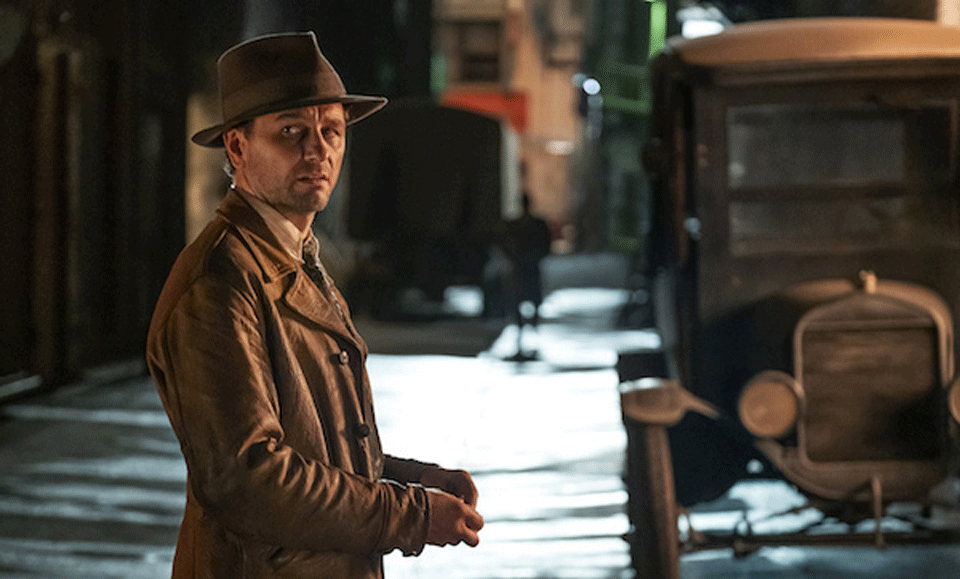
Perry Mason and The Case of the Missing Case
There are many things to like about HBO’s new version of one of the most popular book and television series of all time, Perry Mason, available in Britain on Sky and in France on OCS. This Young Perry Mason, set in the Los Angeles of 1932, is traumatized from his experience in World War I, à la the Peaky Blinders. Perry is also a Lost Generation private detective not above sleazy blackmail himself, à la Jake Gittes in Chinatown. These defects give the character a long way, and multiple seasons, to go before he becomes the staunch defense attorney who enjoys taking the toughest and most hopeless cases.
Matthew Rhys from The Americans is pitch perfect in the role of the talented but befuddled and mixed-up Mason. To this origin story is added that of a bright young African-American beat cop, told by the white officers on the force that he will never become a detective on the LAPD because he is Black, and who we know will eventually become Perry’s investigative ally, Paul Drake.
The period is lovingly and extravagantly recreated, including a flashback trench warfare battle scene that, with the bullets whizzing by, rivals the opening of Saving Private Ryan. The same episode ends in a wide shot of an L.A. downtown street populated with autos. Both scenes suggest that the budget here, and the set construction, are akin to that of HBO’s last global hit Game of Thrones. Costumes also are a marvel of period design and recreation.

So what’s the but? The but is the legal case which must in some way be the justification for the elaborate reconstruction. A single case stretches across all the episodes, and it does, as it unfolds, involve Perry aiding in freeing a client who appears to be as the older Mason might say, “guilty as sin.” The problem is that in the initial episodes the case is a sort of more gruesome Lindbergh Baby Case, updated to the Silence of the Lambs serial-killer era, involving murder instead of kidnapping. The crime, while ruthless, seems to have no wider implications, and seems stuck there just to have Perry, his future assistant Della Street and Paul go through their machinations.
There is a terrific long shot in the opening of episode two which features a disconsolate, dejected and tattered Perry slumped in an alley in the foreground, a drunk collapsed in the middle ground, and two men in tuxedos in the background. This shot illustrates the hopelessness of the Depression, not so different from what is being experienced today, as even CNBC is declaring that in the wake of the Corona Financial Collapse almost half of the US population is without a job. There is also an elaborate construction of a Hooverville, the impromptu collection of shacks that sprang up as the Depression worsened in 1932 and that find their equivalent today under any bridge in L.A. as the always burgeoning homeless crisis adds economic victims of the Corona Crisis to what may soon be named Trumpvilles.
The equally elaborate showbiz temple of a female Christian revivalist Sister Alice (an Aimee Semple McPherson or in the cinema an Elmer Gantry) is a spectacle that rivals Hollywood but seems extraneous because in the 1930s there is already Hollywood as Depression-era diversion. The creator’s explanation for inclusion of this set piece is that it hasn’t been done in Noir period pieces before.
All of which leads to what might be called the “period fetish fallacy” in American film and television. Instead of attempting to grasp the wider social and economic significance of the period, often what substitutes is exact and painstaking reproduction of the minutiae of the era. In the case of Sister Alice, novelty replaces analysis. The year 1932 was a moment in American history where momentous social forces were brewing based on joblessness, forces that would result in both the New Deal and the advancement of American labor and labor unions. That is absent, except as colorful background, from this Perry Mason, which instead lavishes too much time on middle-class divergences like faith healing or tabloid sensationalism.
This is especially damaging since both the former series and the Perry Mason books are excessively plot driven and require an intricate case. So much of this series works that one hopes in the second season the creators will choose to turn their attention away from the minutiae and toward the meaning of the period they have so successfully begun to plumb as a highly original starting point for the show.
Perry Mason and The Case of the Curious Contradictions
“Da, da dum.” These are the opening bars of the Perry Mason theme, as indelibly etched in the brains of viewers of the time as Dragnet’s “Dum, da dum dum.” The series itself, which premiered at what was still the height of the McCarthy era in 1957 and ran through 1968, tended to remake the Perry of the novels, which debuted in the early 1930s in the midst of the Depression, into a more stalwart defender of the law than in his literary manifestation.
The Mason of the 1930s novels, once he determined the client was innocent, often went to great pains to deceive, outmaneuver and trick the police, themselves often portrayed as not just incompetent but underhanded. In 1939’s The Case of the Rolling Bones, Perry orders clients to wipe down their fingerprints, confounds the DA in the necessarily revelatory final courtroom scene by setting up a rummy witness in the audience and reacts angrily to finding his phones tapped by the LAPD. The novel begins with Perry allowing as how he favors poor over rich people because the problems of the latter are “too damn petty.”
When that novel was transferred to CBS in 1958, the counseling clients to break the law is gone, the rummy witness is left out, and the wiretapping is done by an obscure private shamus who informs the police. The last scene has the series’ cop Lieutenant Tragg visiting Perry’s office and informing him of the rogue wiretapping, which results in the trope at the end of each episode, the group guffaw with Perry, Della, Paul and Tragg all having a good laugh. What could be funnier than wiretapping an attorney in an attempt to jail an innocent defendant? The difference is the transposition from the more wide-open Depression era 1930s to the more closed-down corporate climate of the late 1950s.

The show, though, did have its moments. In one of the series’ best episodes, season one’s The Case of the Moth-Eaten Mink, Mason, who has had to face the wrath of the police for supposedly defending a cop killer, confronts, not in the courtroom but in his own law office, the actual killer who is himself part of the judicial system. Mason is still the defender of the weak and wrongly accused, though there is some flattening out of experience as the Klondike prospector in The Rolling Bones is shorn of his early 20th-century rough and tumble appearance and outfitted instead in ’50s corporate attire, a blanding and whitewashing of the character and the barbaric Gold Rush milieu from which his fortune springs.

There is also, in the subtext of the Mason TV show, the tragedy of Raymond Burr, a Hollywood homosexual who could not come out because it would not jive with his image as a staunch defender of the principle of law. This Perry, although he was supposedly enamored of his Gal Friday Della Street, probably preferred the handsome debonair “bachelor” investigator Paul Drake. Burr went so far as to create a fictitious wife and child who he claimed had died in a plane crash.
When questioned about being a “bachelor” of an advancing age, which could lead to the accusation of being gay, he replied that he was not a bachelor but a widower. In the end it seemed he devoted his life to the show in the maintaining of his public image and the denying of his private desire. He was accused of being complicit in not taking a stand, but he was equally the victim of a system and an era that demanded its heroes be stripped and shorn of their human qualities. The TV Perry was often a vanilla version of the Perry of the novels in an era where repression and dull conformity ironed out the human wrinkles that were viewed as splotches on a spotless America.
Thanks for his technical assistance on this article to an extraordinary filmmaker, Sean Dwyer.










